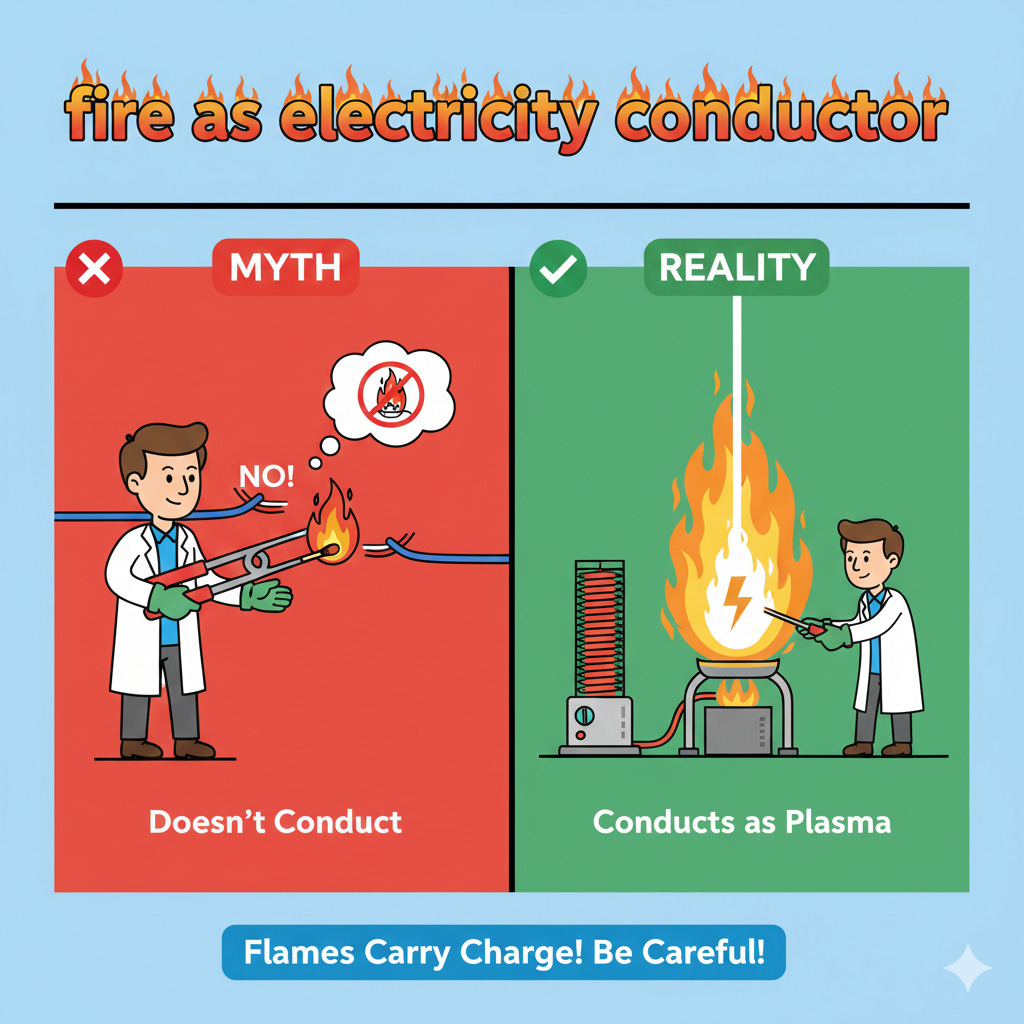
Have you ever wondered if fire can conduct electricity? In this article, I’ll delve into the intriguing question of whether fire, with its mesmerizing dance of flames, has the ability to carry an electric current. Understanding the relationship between fire and electricity can shed light on the science behind these two powerful forces.
As a seasoned blogger with a passion for unraveling scientific mysteries, I’ve conducted thorough research to bring you insights into this fascinating topic. Join me as I explore the properties of fire and electricity, uncovering the truth behind whether these elements can coexist in a conductive relationship. Let’s ignite our curiosity and delve into the electrifying world of fire and its potential connection to electricity.
Key Takeaways
- Fire, being a plasma, can conduct electricity under specific conditions due to the presence of charged particles within the flames.
- Conductivity of fire is influenced by factors like flame temperature, the presence of ions, and the type of fuel burning, impacting the likelihood of electrical conduction.
- Interactions between fire and electricity can lead to visual effects, alter flame behavior, and create unpredictable movement patterns, showcasing the complex relationship between these elements.
- Common misconceptions include the belief that fire does not conduct electricity and that every interaction between fire and electricity leads to explosions.
- Real-life experiments demonstrate that under certain circumstances, fire can conduct electricity, with studies on plasma flames and wildfires illustrating the dynamic interplay between fire and electricity.
Exploring the Conductivity of Fire
When pondering the conductivity of fire, one must delve into the complex nature of both fire and electricity. Fire itself is a chemical reaction that emits light and heat, while electricity involves the flow of electrons. At first glance, it may seem that fire and electricity are vastly different entities, but a closer examination reveals intriguing connections.
Fire is a plasma, a form of matter where atoms are ionized due to the high temperatures involved. This ionization process creates charged particles within the flames, making fire an excellent conductor of electricity. In fact, under certain conditions, fire can indeed conduct electricity.
The conductivity of fire is influenced by various factors such as the temperature of the flames, the presence of ions, and the type of fuel burning. In scenarios where the flames are hot and contain charged particles, the likelihood of electrical conductivity increases. This phenomenon has been observed in diverse contexts, from natural wildfires to controlled laboratory experiments.
Moreover, the behavior of fire in relation to electricity is a captivating area of study for researchers exploring the boundaries between these fundamental elements. By unraveling the mysteries of fire’s conductivity, scientists aim to enhance our understanding of both fire dynamics and electrical conductivity in extreme environments.
What Happens When Fire Meets Electricity?
When fire meets electricity, it can lead to unique interactions that showcase the complex relationship between these two powerful forces. The presence of charged particles within flames allows for the conduction of electricity through fire under specific circumstances.
In some instances, when electricity comes into contact with a flame, it can alter the burning behavior and aesthetic appearance of the fire. The interaction between fire and electricity can result in enhanced visual effects and unpredictable patterns of movement within the flames.
Moreover, the temperature of the flame can influence how electricity behaves when introduced to the fire. Higher flame temperatures can facilitate greater ionization and the formation of more charged particles, potentially affecting the conductivity of the fire.
Researchers continue to study the dynamic interactions between fire and electricity to gain a deeper understanding of these phenomena and their implications in various scenarios. The exploration of what happens when fire meets electricity offers valuable insights into the intricate nature of both elements and their interconnected behaviors.
The Science Behind Fire and Electrical Conductivity
Fire has distinctive properties that allow for unique interactions with electricity. The presence of charged particles in flames enables the conduction of electricity under specific conditions. When electricity encounters a flame, it can influence the fire’s behavior and appearance, resulting in enhanced visual effects and unpredictable flame movements. The temperature of the flame plays a critical role in shaping the behavior of electricity within the fire, with higher temperatures potentially increasing ionization and the formation of charged particles.
Researchers are actively investigating these dynamic interactions to gain a deeper understanding of the intricate relationship between fire and electricity. These studies offer valuable insights into how these two elements interact, leading to a better comprehension of their interconnected behaviors and implications in various scenarios.
Common Misconceptions About Fire and Electricity
When it comes to the relationship between fire and electricity, there are several common misconceptions that often circulate. Let’s address some of these misconceptions to clarify the complex interplay between these two elemental forces:
Misconception 1: Fire Does Not Conduct Electricity
- While it is true that fire itself is not conductive, plasma, which is a state of matter similar to gas but ionized, can conduct electricity. Flames that contain charged particles can indeed serve as conductors under specific conditions.
Misconception 2: Fire and Electricity Always Lead to Explosions
- Not every interaction between fire and electricity results in explosions. The behavior of fire in the presence of electricity can vary based on several factors, such as the temperature of the flame and the amount of charged particles present.
- While electricity can influence the behavior and appearance of fire, it does not fundamentally change the nature of fire itself. The presence of charged particles in flames can enhance visual effects and lead to unpredictable movements, but the essence of fire remains the same.
By debunking these misconceptions, we can gain a better understanding of the nuanced relationship between fire and electricity, shedding light on their intricate interactions that go beyond superficial assumptions or myths.
Examining Real-life Scenarios and Experiments
In real-life scenarios, it’s crucial to understand that fire itself does not conduct electricity. However, the presence of charged particles in flames, like in plasma, can alter this behavior. To explore this further, scientists have conducted various experiments to study the conductivity of fire under specific conditions.
One such experiment involved creating a plasma flame using a high-frequency alternating current. In this setup, the flame exhibited electrical conductivity, demonstrating that under certain circumstances, fire can indeed conduct electricity. This experiment highlighted the role of charged particles in influencing the conductive properties of flames.
Another intriguing study involved analyzing wildfires to observe how electricity interacts with natural fires. Researchers found that in certain cases, lightning strikes during wildfires can influence the behavior of the fire. The electrical discharge from lightning can lead to unique fire patterns and spread, showcasing the complex interplay between fire and electricity in the natural world.
By examining these real-life scenarios and experiments, we can gain a deeper insight into the intricate relationship between fire and electricity. While fire may not conduct electricity in the traditional sense, the presence of charged particles in flames opens up possibilities for unique interactions that continue to fascinate scientists and researchers.
Conclusion
Exploring the intricate relationship between fire and electricity has revealed fascinating insights. While fire itself may not conduct electricity, the presence of charged particles in flames, like in plasma, can lead to unique behaviors. Through experiments and real-life examples, it becomes evident that under specific conditions, fire can exhibit electrical conductivity. The impact of lightning strikes during wildfires further showcases the complex interplay between fire and electricity in nature. These findings challenge common misconceptions and offer a deeper understanding of the dynamic interactions between fire and electricity.
Frequently Asked Questions
Can fire conduct electricity?
No, fire itself does not conduct electricity. However, charged particles in flames, like those found in plasma, can enable fire to exhibit electrical conductivity under certain conditions.
How do lightning strikes during wildfires impact fire behavior?
Lightning strikes during wildfires can affect fire behavior by introducing electrical energy into the flames. This energy can alter the dynamics of the fire, emphasizing the intricate relationship between fire and electricity in nature.
